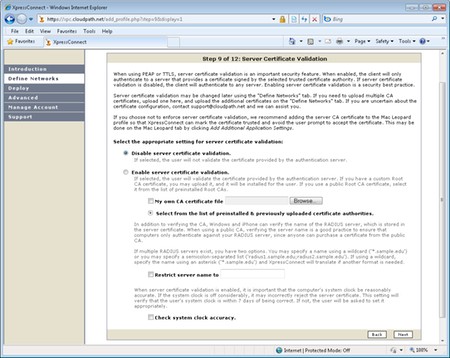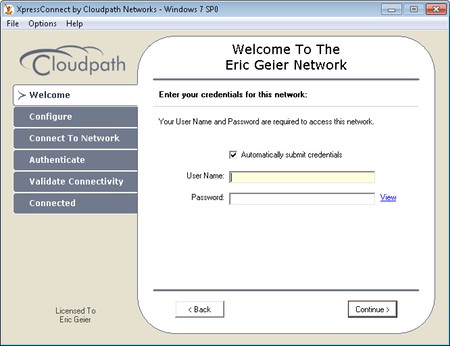Configure security with Cloudpath Networks XpressConnect
Network administration - Enterprise mode of WPA / WPA2 encryption, along with 802.1X authentication, can protect your wireless network with multiple usernames and passwords instead of a PSK or an unsecured password .
However, this mode requires users to make many configuration changes. Client devices must be configured with the server and login details to connect to the network. This is a problem that is difficult for both users and administrators.
Product : XpressConnect of Cloudpath Networks
Advantages : Smart interface, customizable capabilities, complete documentation provided
Disadvantages : Lack of support for EAP-TLS (client side certificates)
Cloudpath Networks has a plan to design a program that makes the process of configuring and connecting to 802.1X networks as easy, fast and secure as possible. Its XpressConnect product allows administrators to create a wizard to automatically configure client devices. The company said its products could reduce the costs associated with WPA-Enterprise, WPA2-Enterprise, or 802.1X networks, while still improving the user experience.
Here we will take a look at whether Cloudpath Networks is successful and can provide what it promises.
As mentioned above, XpressConnect allows administrators to create a wizard so that users can run on their computers (Windows, Mac OS, or Ubuntu Linux computers) or iPhone to automate the configuration. Set up encryption and authenticate PEAP or TTLS for the network. It is also possible to include other network-related settings that can help users connect. Both wireless authentication and 802.1X wired authentication are supported, in addition to WEP, including WPA / WPA2-PSK and unprotected access.
Administrators log into Cloudpath Administrative Console to create and download the XpressConnect interface. They can define network details and customize the wizard interface through the web interface. Administrators can then download the final wizard packaged for Web server or for standalone installation, such as on a CD or USB flash drive. MSI installers can be created and GPO-based deployments are also supported.
Finally, users can run the wizard on their computer or iPhone and this wizard automatically calculates the settings, network configuration and connection to it. This allows users with less experience to connect without the 'one-to-one' support from the help desk or IT group.
An ideal setting is to have an unprotected SSID or a guest VLAN with a locked portal to redirect (redirect) the user to the web installer, where the XpressConnect wizard can configure the user to have an SSID safe. private and full VLAN.
Create the XpressConnect wizard
When you, the administrator, log into Cloudpath Administrative Console (see Figure 1), you will be greeted with a tutorial about how XpressConnect works and a link to download the quick user guide (Quick Start Guide.

Figure 1
Let's start the process by defining network details. The first is Visual Settings. Here you can change the default logo, image, text and other things displayed in the wizard. It is then possible to define related network settings.
This is not a fast-executing task, it is a comprehensive process of 12 steps. This process includes many different settings and has many network problems as well as address configuration - a good thing.
Let's start with the basics, SSID (network name) and encryption / authentication type. Guest devices can even use third-party 802.1X products. You can also specify which operating system will support. In addition, it is possible to address to avoid conflicts between SSIDs by putting your network top on the client's priority list, setting up a specific SSID to manually connect, or delete the network profile for a certain SSID.
You can make the wizard enable certificate validation by selecting the server's Certificate Authority (CA) or uploading yourself. See Figure 2. You can define the server name, which you ensure they only connect to your RADIUS server. You even have a wizard to check the user's system clock, which, if incorrect, can cause problems with certificate validation.

Figure 2
An additional bonus that you can accumulate and enable on the wizard if needed, Windows Auto Updates, Firewall, NAP, etc. See Figure 3. With Windows 7, you can even disable Wireless Hosted Networks, this is The part can pose a security risk to your network.

Figure 3
When the XpressConnect wizard allows your users to connect, it can open their web browser with the URL you choose. You can also put a return shortcut on their desktop when they want to undo the changes to the wizard.
We implemented and created a test network here in the office and found that the settings are well documented. Each option is expanded to see more information about it. Settings and options themselves only show how complex XpressConnect is.
Use the XpressConnect wizard to configure the client
Next we will test the wizard to test the user experience. First, download a standalone installation package, unzip it and place the files on a CD. Then go to Windows 7 and Windows XP computers.
When inserting the CD, the XpressConnect wizard will automatically appear. See Figure 4. We enter the username and password for our 802.1X test network and click Continue. The program has been active and the message indicates that the connection was successful. It even allows you to see exactly what changes are made to your computer and give us an option to create a desktop shortcut. It takes no more than a minute to connect.

Figure 4
We also tested the method of deploying Web server. Download an HTML package, extract it and upload the files to the web server. When you access the URL, it will download a Java Applet or ActiveX program, something similar to the XpressConnect wizard when done in a standalone method. In the implementation we had no problems, the system worked like the previous method.
Conclude
It can be said that XpressConnect is a solid product. Cloudpath Networks has done what it promised. Its smart interface can reduce the time and cost of supporting 802.1X networks. In addition, it allows users to use it in a friendly way. In addition, XpressConnect has excellent customization and documentation capabilities.
The only problem is that the software does not support EAP-TLS. XpressConnect only works with PEAP and TTLS settings, regarding 802.1X authentication. However, this is one of the most popular implementations today.
You should read it
- Secure WiFi in enterprise environment from basic steps
- Israel launches the world's first cybersecurity network
- The best network configuration management tools and software
- Test on computer network with answer P9
- Learn about Personal Area Network (PAN)
- The basic steps in dealing with network security issues that you need to understand
- Securely protect information on Wi-Fi network
- Instructions for use and security of Wifi network
May be interested
- Dangerous security flaw allows hackers to monitor Wi-Fi networks and steal information
 according to techradar, a serious security flaw has just been discovered in the ieee 802.11 wi-fi standard that can be easily exploited by hackers to infiltrate and secretly spy on users' networks.
according to techradar, a serious security flaw has just been discovered in the ieee 802.11 wi-fi standard that can be easily exploited by hackers to infiltrate and secretly spy on users' networks. - How to Configure Firewall on Debian Using UFW
 ufw provides a user-friendly way to control incoming and outgoing traffic, strengthening your system's defenses against unauthorized access and potential threats.
ufw provides a user-friendly way to control incoming and outgoing traffic, strengthening your system's defenses against unauthorized access and potential threats. - Top 10 social networks to replace Facebook (part 2)
 in the previous section of the article, we introduced the 5 largest social networks today and can easily replace the facebook giant. the following section will continue to suggest 5 social networks are growing in the world and will bring you extremely new experiences.
in the previous section of the article, we introduced the 5 largest social networks today and can easily replace the facebook giant. the following section will continue to suggest 5 social networks are growing in the world and will bring you extremely new experiences. - Configuring play Layer Of Fear on computer
 you can choose to configure it to a high or low graphics level to experience the layer of fear 2 in this article.
you can choose to configure it to a high or low graphics level to experience the layer of fear 2 in this article. - 9 misunderstand about social networks
 today social media has changed the way we sell, marketing and public relations - but there are still many misconceptions and misunderstandings about social networks (mxh). here are the 9 most common misunderstandings about social media and related research.
today social media has changed the way we sell, marketing and public relations - but there are still many misconceptions and misunderstandings about social networks (mxh). here are the 9 most common misunderstandings about social media and related research. - How to Configure a Router
 the router is an important device in the home network. if you configure your router properly, you can keep your information secure from snoopers, securely connect every device in your home to the internet, and even keep your children from seeing things they shouldn't. see. follow the steps in this article to configure your router in just a few minutes.
the router is an important device in the home network. if you configure your router properly, you can keep your information secure from snoopers, securely connect every device in your home to the internet, and even keep your children from seeing things they shouldn't. see. follow the steps in this article to configure your router in just a few minutes. - Protect users to get secure networks
 as an it administrator, security advisor, computer expert, there are more problems on your list of network environments than security issues. there are millions of dollars, thousands of hours of work and even an attempt
as an it administrator, security advisor, computer expert, there are more problems on your list of network environments than security issues. there are millions of dollars, thousands of hours of work and even an attempt - How to Install, Configure, and Test Windows Server 2012 R2
 windows server 2012 r2 operating system has features that support domain enterprise networks of varying sizes, but to realize the benefits of these features, you must first install, configure, and test it. create the operating system...
windows server 2012 r2 operating system has features that support domain enterprise networks of varying sizes, but to realize the benefits of these features, you must first install, configure, and test it. create the operating system... - Free Wi-Fi security tools
 the article introduces you to some of the tools used in wi-fi networks: search engines and roaming security (roaming security) ...
the article introduces you to some of the tools used in wi-fi networks: search engines and roaming security (roaming security) ... - What is Network Security and the benefits it brings?
 network security is defined as a set of measures and technologies to protect the integrity, usability and availability of computer networks.
network security is defined as a set of measures and technologies to protect the integrity, usability and availability of computer networks.










 Remote workstation security in Windows Server 2008 R2
Remote workstation security in Windows Server 2008 R2 Kaspersky's free support security utilities
Kaspersky's free support security utilities Solutions to help businesses confidently delete data
Solutions to help businesses confidently delete data Release the free tool to kill ZBot malware
Release the free tool to kill ZBot malware Google secures 2-level user accounts
Google secures 2-level user accounts 3D map - the future of online passwords
3D map - the future of online passwords